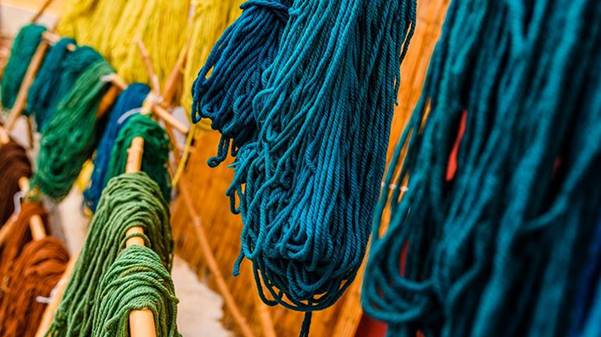
Disperse Dye
Disperse dyes are non-ionic, water-insoluble dyes primarily used for dyeing synthetic fibers such as polyester, acetate, and nylon. They are finely ground and dispersed in water using dispersing agents. Unlike reactive dyes, disperse dyes do not form chemical bonds but are absorbed and diffused into the fiber under high temperature and pressure. They offer excellent resistance to washing, light, and perspiration. Disperse dyes are commonly applied using high-temperature dyeing methods like thermosol, high-pressure, and carrier dyeing processes.
| Property | Details | Typical Values | Application Method | Fiber Compatibility | Fastness |
|---|---|---|---|---|---|
| Chemical Nature | Non-ionic | Azo, Anthraquinone | High Temp Dyeing | Polyester, Nylon | Light: 6–7, Wash: 4–5 |
| Molecular Weight | Moderate | 250–600 g/mol | Carrier / HT-HP | Acetate, Acrylic | Rub: 3–4 |
| Solubility | Insoluble in water | Dispersed in water | Pad-dry-cure | Polyester Blends | Good |
| Dyeing Temp | High | 130°C typical | Thermosol | Hydrophobic fibers | Excellent |
| pH Range | Slightly Acidic | 4.5 – 6.5 | Exhaust method | Synthetic fibers | 4–5 |
| Physical Form | Fine powder/liquid | Dust-free granules | Pad-batch | Nylon 6/66 | Fair–Good |
| Shelf Life | Stable | 2–3 Years | Stored cool/dry | All polyesters | Consistent |
| Environmental | Compliant | OEKO-TEX / REACH | Low effluent | Sustainable blends | Eco-safe |
| Property | Description | Typical Range | Application Method | Compatible Fibers | Fastness Rating |
|---|---|---|---|---|---|
| Chemical Class | Anionic dye, typically Acid-based | Monoazo, Anthraquinone structures | Exhaust dyeing (batch process) | Wool, Silk, Nylon | Wash: 3–4, Light: 4–5 |
| Molecular Structure | Small organic molecules | 300–600 g/mol | Pad-batch or pad-dry methods | Nylon, Leather, Silk | Rub: 3–4, Light: 5–6 |
| Solubility | Fully water-soluble | High dispersion stability | Pad-dry-cure | Protein-based fibers | Fair to Good |
| pH Range | Requires acidic bath | pH 4.0 to 6.0 | Steam fixation / pressure dyeing | Silk, Nylon, Wool | Light: 5–6, Wash: 4 |
| Dyeing Temperature | Requires moderate heat | 85°C – 100°C | Exhaust / Continuous | Wool blends, Silk | Rub: 3–4 |
| Physical Form | Powder, Granules or Liquid | Fine, low-dust formulation | Continuous dyeing machines | Silk, Viscose, Nylon | Stable, Consistent |
| Shelf Life | Highly stable in dry storage | Up to 24 months | Avoid moisture, direct sunlight | All protein & synthetic fibers | Reliable performance |
| Environmental Compliance | Eco-certified formulations | GOTS, OEKO-TEX, REACH | Low effluent discharge | Bio-degradable dyes available | Eco-friendly / Sustainable |
Disperse dyes are a category of non-ionic, water-insoluble synthetic dyes specifically engineered for dyeing hydrophobic fibers such as polyester, acetate, and nylon. These dyes are applied in the form of finely ground particles dispersed in water using dispersing agents. They penetrate synthetic fibers under high-temperature and pressure conditions, delivering excellent color depth, evenness, and fastness. Disperse dyes are ideal for achieving vibrant shades on fabrics where other dye types may fail to bind effectively.
From a chemical processing perspective, disperse dyes operate best in a temperature range of 120°C to 135°C under pressurized dyeing conditions or via thermosol methods at 180°C to 210°C. Their performance does not rely on fiber reactivity but rather on diffusion and sublimation into the fiber. pH levels are typically neutral to slightly acidic (4.5–5.5), with carrier agents sometimes used to aid dispersion at lower temperatures. These dyes are widely used in apparel, sportswear, automotive textiles, and technical fabrics due to their superior dry and wet fastness characteristics.
Industrial use of disperse dyes demands careful handling and storage — they must be kept in airtight containers in a cool, dry area to avoid moisture absorption. Most high-grade disperse dyes are formulated to meet ecological and regulatory standards such as OEKO-TEX and GOTS compliance. Chemical engineers and dyeing technicians focus on optimizing dye bath parameters, minimizing residue, and reducing effluent load, making disperse dyes a key element in sustainable synthetic textile production.
Our Lab Gallery



If you would like to get in touch with JP Global, there are several convenient ways to reach out. You can contact us directly via phone or email for any inquiries, partnerships, or support. Additionally, our contact form on the website allows you to submit your queries quickly. For urgent matters, we recommend calling during business hours. Follow us on social media for updates, or visit our office at the listed address to speak with our team in person.
You can view the complete list of our products by visiting the "Products" or "Catalog" section on our website. We regularly update this section with the latest offerings, specifications, and availability. If you prefer, you can also request a digital or printed catalog by contacting our support team via email or phone. For bulk or customized product inquiries, our sales team is always ready to assist you directly.
JP Global collaborates with a wide range of trusted industrial partners across various sectors including manufacturing, logistics, energy, and technology. Our key partners include leading suppliers, global manufacturers, and certified service providers who share our commitment to quality, innovation, and customer satisfaction. These collaborations enable us to deliver reliable solutions and maintain high industry standards in every project we undertake.





















